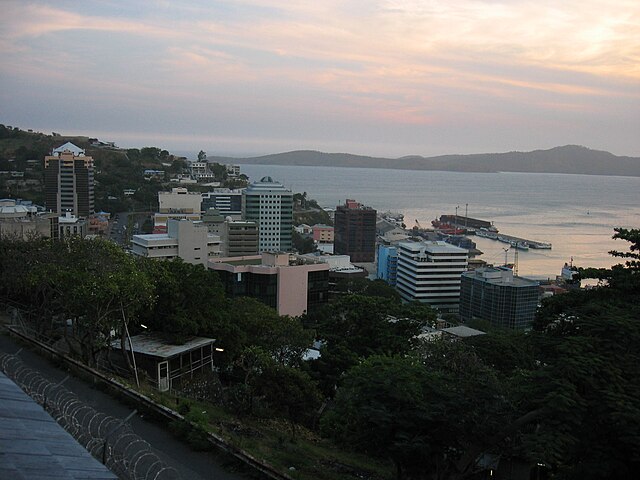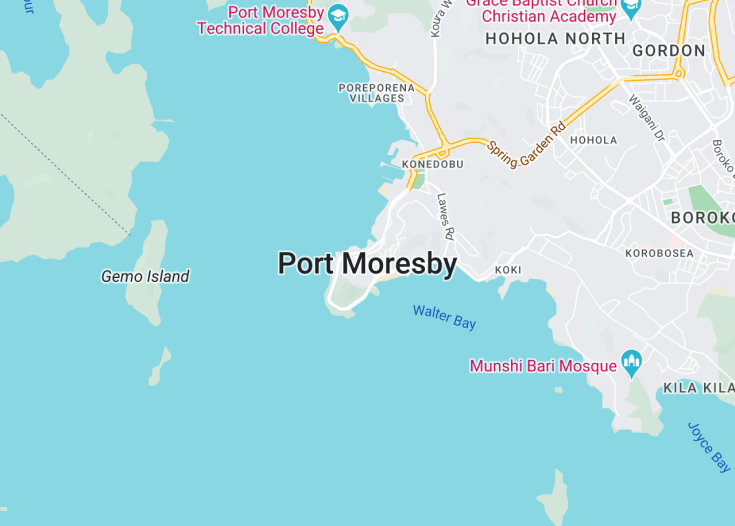Port Moresby, the capital and largest city of Papua New Guinea, stands as a gateway to the diverse cultures and landscapes of this unique country. Located on the shores of the Gulf of Papua, it offers a mix of modern urban settings and rich, traditional heritage. Important sites include the Parliament Haus, built in the style of a Maprik house, and the National Museum and Art Gallery, which houses artifacts from the country’s various ethnic groups. Despite facing urban challenges, Port Moresby is developing rapidly, providing visitors a vibrant blend of history, culture, and natural beauty.
For a genuine taste of local life, visit the bustling markets of Port Moresby, such as Gordons Market, where you can find everything from fresh produce to handcrafted souvenirs.</ryption
Plan to visit during the dry season from May to October, when the weather is more accommodating for exploring the outdoor attractions and cultural sites.
Top things to do & see in Port Moresby
Select the following sights and activities to discover best tickets and tours available in Port Moresby.
Port Moresby: Gateway to Adventure
| Country | Papua New Guinea |
| Time in Port Moresby | GMT+10 |
| Language spoken | Tok Pisin, English |
| Population | 383,000 (Source: World Population Review) |
| Currency | Papua New Guinean Kina (PGK) |
| Airports | Jacksons International Airport (7 mi / 11 km). |
Port Moresby, the bustling capital city of Papua New Guinea, serves as the principal gateway into the country. Located on the shores of the Gulf of Papua, the city presents a blend of traditional culture and modern dynamics. Known for its vibrant markets and colonial history, Port Moresby offers visitors a unique insight into the Melanesian way of life.
The city’s rich history dates back to its naming after Captain John Moresby in 1873, and it has grown from a small outpost into a critical regional hub. Port Moresby is host to a variety of cultural and historical landmarks, including the National Parliament House, which features traditional design elements fused with modern architecture.
The city serves as an ideal starting point for exploring the lush landscapes of Papua New Guinea, ranging from rainforests to volcanic mountains. Among its numerous offerings, the Port Moresby Nature Park stands out, providing a sanctuary for native wildlife and a botanical garden that exhibits the country’s diverse flora. This locale has become a symbol of conservation efforts in the Pacific region and highlights the city’s pivotal role in ecological preservation.
Port Moresby is also known for hosting the annual Hiri Moale Festival, celebrating the traditional trade voyages by the Motuan people of the region. This event features elaborate performances, canoe races, and showcases the unique cultural tapestry of Papua New Guinea.
Despite some challenges related to urban growth, the city continues to progress and develop, with improvements in infrastructure and services. It remains not just the diplomatic and administrative heart of Papua New Guinea, but also a testament to the resilience and diversity of its people.
Where is Port Moresby?
Port Moresby is located on the southeastern coast of Papua New Guinea and overlooks the Coral Sea.
Distances:
| Route | Distance by car | Time by car |
|---|---|---|
| Laotto Port Moresby | 823 km | 18 hrs |
| Madang to Port Moresby | 640 km | 15 hrs |
What is Port Moresbyfamous for?
Port Moresby is famous for its strategic importance as a cultural and commercial hub in the Pacific, rich cultural festivals, diverse wildlife in surrounding areas, and significant WWII history sites.
History
Pre-20th Century
Port Moresby, now the bustling capital of Papua New Guinea, has a rich history that traces back to its original inhabitants, the Motu-Koitabu people. Before the arrival of Europeans, these indigenous groups thrived through innovative trade, particularly known for the “Hiri” trade expeditions, which saw them exchanging pottery for sago with their neighbors. The area was first sighted by Westerners in the 1870s, with its name deriving from Captain John Moresby, who was the first European to set foot on the site, mapping the harbor and surrounding regions.
20th Century and World War II
The turn of the 20th century marked significant transformations in Port Moresby. It became an important outpost during World War II, serving as a pivotal point for battles between Japanese and Allied forces. The city’s strategic position made it a target, but it also became a crucial base for counter-attacks. Post-war, Port Moresby experienced rapid development and modernization as it transitioned from an Australian territory to the capital of the independent state of Papua New Guinea in 1975.
1975 to Present
Since gaining independence, Port Moresby has faced both challenges and developments. Rapid urbanization has brought about infrastructural advancements, but also social challenges like housing and crime. Today, the city stands as a symbol of progress in Papua New Guinea, displaying a blend of traditional Melanesian culture and modern urban life. It hosts several institutions, including the University of Papua New Guinea, and is a driving force in the nation’s politics and economy.
Visit Port Moresby
What to see and do in Port Moresby
In Port Moresby, visitors can explore a variety of attractions that offer insights into the nation’s culture and natural beauty. The Port Moresby Nature Park is a must-see, housing a diverse collection of native flora and fauna. History enthusiasts will appreciate the National Museum and Art Gallery, which showcases traditional and contemporary art from across Papua New Guinea.
- Attend the Hiri Moale Festival, a vibrant celebration of the city’s Motuan heritage.
- Visit the Bomana War Cemetery, a solemn tribute to the soldiers who lost their lives during World War II.
- Explore the Ela Beach for a relaxing day by the sea and local markets for handicrafts.
Annual Events in Port Moresby
Port Moresby hosts several cultural and festive events throughout the year. The most notable is the Hiri Moale Festival, which occurs around the Independence Day celebrations in September. This event revives the historical Hiri trade and includes a variety of cultural performances, canoe races, and traditional displays. Another significant event is the Papua New Guinea Arts and Cultural Festival, held biennially, showcasing a panorama of dance, music, and art from across the country.
Best time to visit Port Moresby
The best time to visit Port Moresby is during the dry season, from May to October. During these months, the weather is more favorable, with less rainfall and lower humidity, making it ideal for outdoor activities and exploring the city.
Is Port Moresby worth visiting?
Port Moresby presents an intriguing blend of traditional Pacific culture and modern development. While it offers landmarks of historical significance and cultural depth, potential visitors should be aware of the city’s challenges, such as safety concerns due to crime rates. The city requires cautious exploration but can be a rewarding destination for those interested in the rich tapestry of Papua New Guinean traditions and nature. Tourists looking for an off-the-beaten-path experience will find it here, though it’s advisable to stay well-informed and vigilant during their visit.










